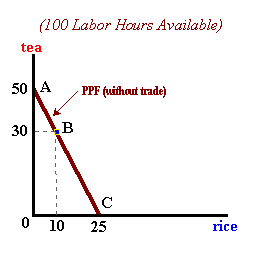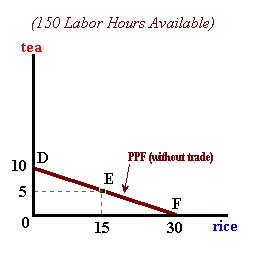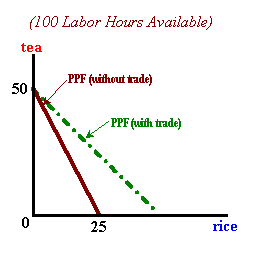| figure 1a, Indonesia | figure 1b, Thailand |
 |
 |
For many years, economists sought to understand the motivations behind the trading and exchange of goods and services among individuals, regions, and nations.
It was first thought that trade was the result of a given nation (or firm) exploiting its Absolute Advantage in production of goods relative to the productive ability of other nations (firms) . A country is said to have the Absolute Advantage in production if it can produce the same amount of output with less input relative to other countries. For example, given the following data:
| 1 kg. of Rice | 1 kg. of Tea | |
| Indonesia | 5 hrs. labor | 2 hrs. labor |
| Thailand | 3 hrs. labor | 6 hrs. labor |
In this case, Indonesia has the absolute advantage in tea production and Thailand the the absolute advantage in rice production. Based on this concept of production advantage, Indonesia should devote its resources to and specialize in tea production. Thailand should specialize in rice production and export some of this rice in trade for Indonesia's tea.
However, it was often observed that one country possessed the absolute advantage in the production of both (all) goods.
| 1 kg. of Rice | 1 kg. of Tea | |
| Indonesia | 4 hrs. labor | 2 hrs. labor |
| Thailand | 5 hrs. labor | 15 hrs. labor |
We might expect that in such a case, this country (Indonesia in the above example) would find it more efficient to engage in production of all goods to meet domestic consumption needs and avoid relationships with its economic partners. In reality, trade still takes place among nations, even though one country lacks an absolute advantage in the production of any good.
Trade, and the gains from trade, is better explained by the concept of Comparative Advantage. This concept is based on the notion of opportunity costs within one country as compared to its economic partners. For example, in table 2 above we find that in Indonesia, in order to produce one more unit of rice, resources must be pulled from their next best use -- tea production. Specifically,
1 unit of rice will require the sacrifice of 2 units of tea
since 1 kg. of rice requires 4 hours of labor input that must be drawn from tea production. Pulling 4 labor hours away from tea, means giving up the production of 2 kg. of tea (each 'kilo' of tea requiring 2 labor hours). This sacrifice of tea represents the opportunity cost of producing each additional unit of rice.
Thus in the case of Indonesia
1 unit of rice will "cost" of 2.0 units of tea
1 unit of tea will "cost" of 0.5 units of rice
and in the case of Thailand
1 unit of tea will "cost" of 3.0 units of rice
1 unit of rice will "cost" of 0.333 units of tea
Thus the opportunity costs of rice production (1 kg.) are lower in Thailand [0.333 kg. of tea rather than 2.0 kgs. of tea]. Thailand should specialize in rice production.
In Indonesia, the opportunity costs of tea production (1 kg.) are lower than in Thailand [0.50 kg. of rice rather than 3.0 kgs. of rice]. Indonesia should specialize in tea production.
| figure 1a, Indonesia | figure 1b, Thailand |
 |
 |
Suppose that Indonesia does specialize in tea production and Thailand specializes in rice production. Chances are that consumers in both countries would like to be able to consume both goods. Thus Indonesia would like to import some rice and export tea and Thailand would like to import tea in trade for rice.
It would be necessary for these two countries to agree on a Terms of Trade (ToT) to allow the exchange process to go forward.
Suppose that these two countries agree on a ToT of:
1 rice = 1 tea.
Indonesia would benefit since that country could now acquire 1 rice at a trading cost of 1 tea which is less than the domestic opportunity costs of 2.0 kg's. of tea.
Thailand would benefit since that country could now acquire 1 tea at a trading cost of 1 rice which is less than the domestic opportunity costs of 3.0 kg's. of rice.
As long as the ToT is less than domestic opportunity costs in each country, an incentive for trade will exist. The the case of Indonesia and Thailand the ToT (tea : rice) will fall in the following interval:
{Thailand's opp. costs} 1:3 < ToT < 2:1 {Indonesia's opp. costs}
| figure 2a, Indonesia | figure 2b, Thailand |
 |
 |
Referring to the diagrams in Figure 2, suppose we have the following:
Without Trade
Indonesia produces and consumes: 15 units of rice and 20 units of tea
Thailand produces and consumes: 15 units of rice and 5 units of tea
Indonesia has the comparative advantage and will specializes in tea production:
Indonesia With Trade
:Produce: 50 units of tea
Consumes: 35 units of tea
Exports: the remaining 15 units of tea and imports 15 units of rice at the terms of trade of 1:1.
Consumes: 15 units of rice
Indonesia's gains from trade are 15 additional units tea consumed.
Thailand has the comparative advantage and will specializes in rice production:
Thailand With Trade
:Produce: 30 units of rice
Consumes: 15 units of rice
Exports: the remaining 15 units of rice and imports 15 units of tea at the same terms of trade.
Consumes: 15 units of tea
Thailand's gains from trade are 10 additional units of tea consumed.
This analysis of specialization, exchange, and gains can be extended to any pair of economic agents trading with one-another. Individuals, firms. countries and regions find it beneficial to specialize in the production of those goods or services where they have the comparative advantage. The consumption of a mix of goods is made possible through trade and exchange often through market transactions -- transactions that are mutually beneficial to all agents.
.